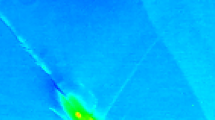Abstract
Cathodoluminescence (CL) spectroscopy in a scanning electron microscope was used to identify and to map the spatial distribution of luminescent defects in a synthetic diamond single crystal. Several defect CL bands were observed in the 1.5-3.5 eV region: (i) a band with a zero-phonon line at 2.156 eV, attributed to a center containing nitrogen and atomic vacancies; (ii) a broadband centered at ∼2.2 eV, tentatively attributed to a boron-containing center; (iii) a doublet line at 2.33 eV, attributed to a nitrogen-containing center; (iv) a zero-phonon line at 2.555 eV, attributed to a nickel-containing center; (v) a broadband centered at ∼2.85 eV, attributed to a dislocation-related center; and (vi) a zero-phonon line at 3.188 eV, attributed to a center containing nitrogen and a carbon interstitial. Lines due to free and acceptor-bound excitons were observed in the 5.0-5.4 eV region. The spatial variation of the CL was examined in the vicinity of regions of relatively high dislocation density (∼106 dislocations cm−2), which had been found in a previous x-ray diffraction imaging experiment. A quantitative analysis was made of the spatial variation of the band intensities. Upon moving from a relatively defect-free region to the center of a high dislocation density region, the intensities of defect bands (i) and (v) increased by very large factors (these bands were observed only within the high dislocation density regions); the intensity of defect band (vi) increased by a factor of ∼2; the acceptor-bound exciton intensity increased by a factor of 1.3; the intensities of defect bands (ii)-(iv) decreased by a factor of ∼2; and the free exciton intensity decreased by a factor of ∼7.5.
Similar content being viewed by others
References
B. K. Tanner, X-Ray Diffraction Topography (Pergamon Press, Oxford, 1976).
D. R. Black, H. E. Burdette, and W. E. Banholzer, Diamond and Related Mater. 2, 121 (1993).
L. H. Robins, L. P. Cook, E. N. Farabaugh, and A. Feldman, Phys. Rev. B 39, 13367 (1989).
G. Davies, in The Properties of Diamond, edited by J. E. Field (Academic Press, San Diego, CA, 1979), p. 165.
A. T. Collins, in Diamond Materials, edited by A. J. Purdes, J. C. Angus, R. F. Davis, B. M. Meyerson, K. E. Spear, and M. Yoder, Electrochem. Soc. Proc. Vol. 91–8 (The Electrochemical Society, 1991), p. 408.
J. Ruan, K. Kobashi, and W.J. Choyke, Appl. Phys. Lett. 60, 3138 (1992).
L. H. Robins, E. N. Farabaugh, A. Feldman, and L. P. Cook, Phys. Rev. B 43, 9102 (1991).
A. T. Collins and S. C. Lawson, J. Phys.: Condens. Matter 1, 6929 (1989).
H. Kawarada, Y. Yokota, Y. Mori, K. Nishimura, and A. Hiraki, J. Appl. Phys. 67, 983 (1990).
V. S. Vavilov, A. A. Gippius, A. M. Zaitsev, B. V. Deryagin, B. V. Spitsyn, and A. E. Aleksenko, Fiz. Tekh. Poluprovodn. 14, 1811 (1980); [Sov. Phys. Semicond. 14, 1078 (1980)].
A. T. Collins, M. Kamo, and Y. Sato, J. Phys. D 22, 1402 (1989).
L. H. Robins, E. N. Farabaugh, and A. Feldman, J. Mater. Res. 7, 394 (1992).
A. T. Collins, H. Kanda, and R. C. Burns, Philos. Mag. B 61, 797 (1990).
N. Yamamoto, J. C. H. Spence, and D. Fathy, Philos. Mag. B 49, 609 (1984).
R. J. Graham, T. D. Moustakas, and M. M. Disko, J. Appl. Phys. 69, 3212 (1991).
R. J. Graham and K. V. Ravi, Appl. Phys. Lett. 60, 1310 (1992).
A.T. Collins and G.S. Woods, J. Phys. C 20, L797 (1987).
A.T. Collins and S.H. Robertson, J. Mater. Sci. Lett. 4, 681 (1985).
P.J. Dean and I.H. Jones, Phys. Rev. 133A, 1698 (1964).
P. J. Dean, E. C. Lightowlers, and D. R. Wight, Phys. Rev. 140A, 352 (1965).
H. Kawarada, Y. Yokota, and A. Hiraki, Appl. Phys. Lett. 57, 1889 (1990).
H. Kawarada, Y. Yokota, H. Matsuyama, T. Sogi, and A. Hiraki, in Diamond Materials, edited by A. J. Purdes, J. C. Angus, R. F. Davis, B. M. Meyerson, K. E. Spear, and M. Yoder, Electrochem. Soc. Proc. Vol. 91–8 (The Electrochemical Society, 1991), p. 420.
Author information
Authors and Affiliations
Rights and permissions
About this article
Cite this article
Robins, L.H., Black, D.R. Defect mapping of a synthetic diamond single crystal by cathodoluminescence spectroscopy. Journal of Materials Research 9, 1298–1306 (1994). https://doi.org/10.1557/JMR.1994.1298
Received:
Accepted:
Published:
Issue Date:
DOI: https://doi.org/10.1557/JMR.1994.1298




